Craig Edwards Interview
- Posted on
- By Woz, G. Keller
- Posted in Interviews, Tech

Recently we had the pleasure of chatting with Craig Edwards, who aside from being one of the founders and the brain behind Sweet Parts, also designed the eeBrake, and the eeWing, among other parts in the ee product lineup.
Craig Edwards has been designing parts, and innovating in the bike world since the early 1990's. During our talk we got to hear the chronology of his time in the bike industry, as well as ask him a few questions about some of his most popular designs.
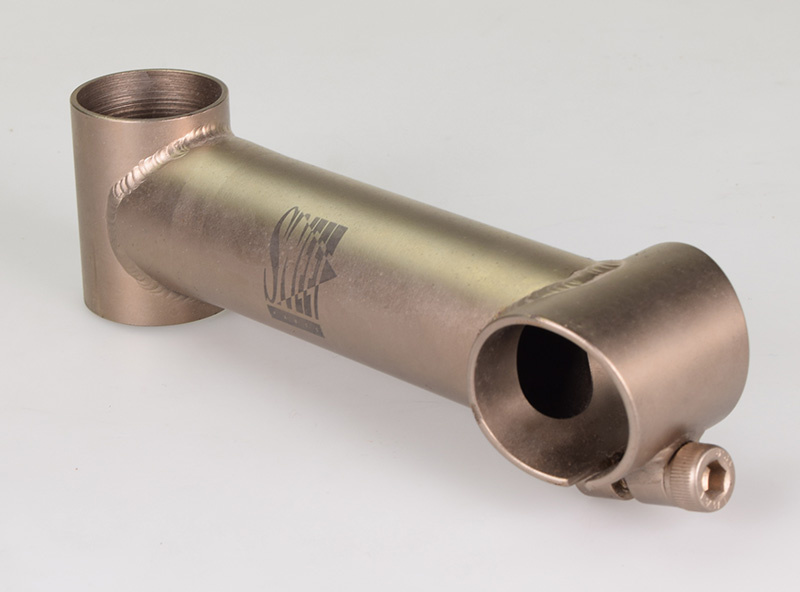
The Sweet Top. One of Craig's many masterful designs.
The Sweet years:
I don't believe bicycles have ever been your 9 to 5, correct? What is?
I am an architect and practiced architecture full time doing custom houses for most of my working life. Cycling and developing bike parts was something I did for the love of design as a hobby. It was not until eeCycleworks grew to more than a hobby and I had effectively 2 jobs that I decided to work solely on bike parts after 30 years of architecture. I think that was around 2012.
Why jump into the bike industry when you already had a good career? Was it a conscious decision or did it just sort of happen?
I started designing bike parts around the early 90's when I had some ideas on stems and discussed them with a cycling buddy, Kent Carlson. He was very interested in starting a business and strongly encouraged me to give it a go and see what we could do. I was resistant because I already had a full-time job that I loved, but I also loved designing things too much to say no. I just love to design things. It's really that simple. With Sweet Parts, I was not interested in starting a business in the bike industry. I did not want to be involved in the business part of it, so I let others handle that completely.
Was Sweet Parts your first bike company?
Yes. It was a partnership with my cycling buddy Kent and eventually resulted in additional partners who brought the cash needed to get started. I only did the design work at the start, but soon handled the product development and manufacturing because we had no other way to continue. When you start a business with difficult parts to execute, no track record, and limited cash, it is very hard to get real pro's involved.
What was the release order of Sweet Parts and was there any particular reason for the order?
The stem was first. I can remember the typical road stem at that time was almost solid forged aluminum with a long steel bolt. I thought 'this is crazy, it should be hollow and designed to use a small, light bolt to make it stiff and light'. So we made a stiff light stem of chromoly. I remember the first stupid light stem prototype we made barely made it 1 ride. I noticed something was not right after a 10-mile 40 MPH descent. It had almost cracked in half by the bottom of the hill. I was so thankful it lasted that long and obviously made some changes after that.
The crank came a year or so after that. It was the same drill, cranks used a small diameter steel axle and solid aluminum arms - heavy and not stiff. The crank applied a large diameter thin wall chromoly again to be structurally super efficient.
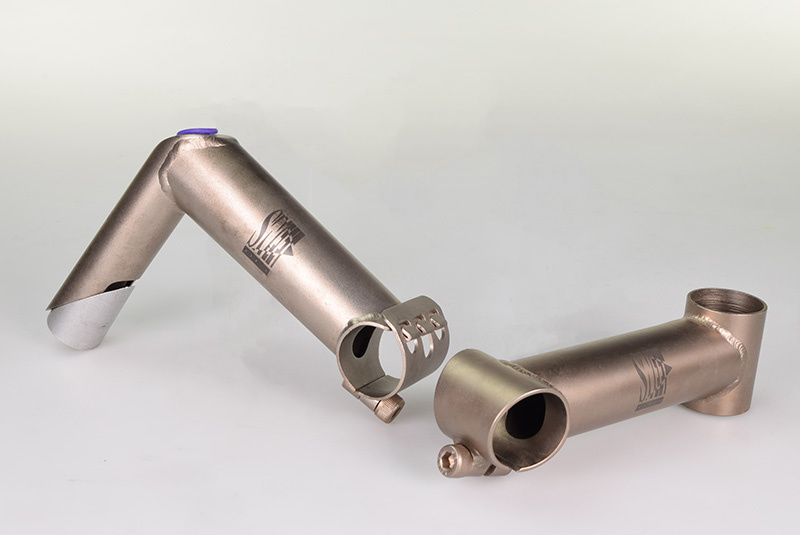
Sweet Stem with removable faceplate (left) and the Sweet Top (right)
What happened to cause the end of Sweet Parts and when was that?
1996, plus or minus. It was a combination of things that led to our downfall. 1) I was really fried in manufacturing and hauling parts from vendor to vendor to get them made. 2) We tried to grow too fast and spent too much money too fast thinking we had to get market share versus growing slowly, steadily, and maintaining sustainability.
For 30 years there have persisted rumors of an original titanium Sweet Wing crankset. Care to shed any light on when/where/why/how etc...
Yes, we made 5 prototypes. The TI metal company Timet gave us the material - a heat-treatable TI alloy called 15-3-3-3 (Timetal 15-3) and they even made custom seamed arm tubing for us! 15-3 could be heated to the strength of CROMO, so I used close to the same wall thicknesses as the CROMO crank knowing it would not be as stiff. Some changes were required on the spider because TI can't be laser cut. Everything about the TI cranks was difficult as TI is hard to machine and tricky to weld. I think we lost 2 in the process and ended up with 3.
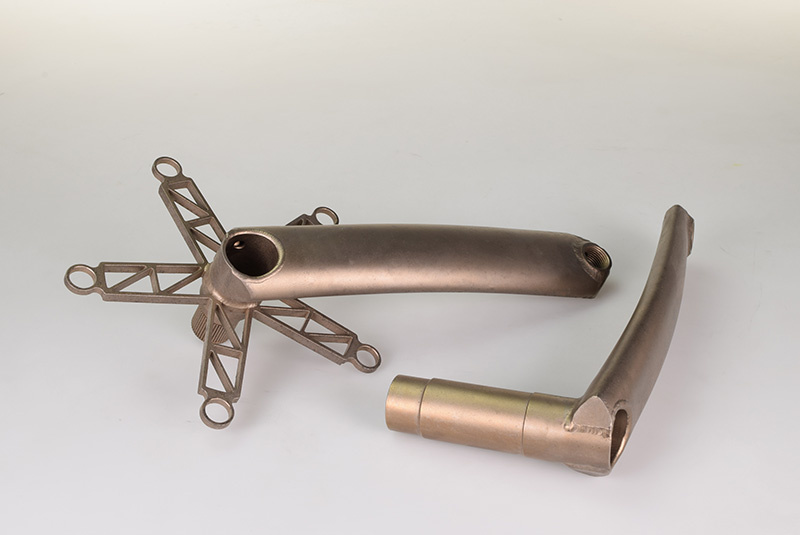
Early Sweet Wing crankset.
What happened and why didn't they make production? Do you remember how they compared in weight and stiffness to the steel version?
Honestly, I am not sure what happened to them. I for sure wanted to keep 1 set, but they disappeared and I looked everywhere for them! They were stupid light - about 40% lighter than the steel version!!! They weren't as stiff as the steel cranks but were still stiffer than our competitors. At that time the TI cranks were made purely for the hell of it and we knew production was probably not going to happen as we were struggling to make steel cranks.
What was the purpose of basing the spider around the ring wranglers, was it to solve an issue or an innovation?
The ring wranglers came about as a result of our manufacturing limitations and the goal of keeping things as light as possible. We laser cut the spider from the plate, and making a spider for 2 bolt circles would have required machining it out of a much thicker plate, adding weight and cost. As an architect, my lack of experience and knowledge of engineering/manufacturing processes limited me from finding a better solution as well! In architecture +/- 1/4" is fine, but in the manufacturing world +/- .001" can be critical and it's not just saws and hammers. One interesting thing on tech that we did use was FEA. At the time it was used in defense and aerospace, but my partner, Kent, had a buddy that provided that service and was willing to do it for us. It really helped us in optimizing our product designs and wall thicknesses. (At this time, this tech was not used by many and probably not in the bike industry at all. FEA was crude then compared to today's standards and sometimes took a day or more to run/complete 1 load case on the computer.)
Looking back, the original sweet wings (alongside Alex's original magic motorcycles) are still today some of the most revered cranks ever. It's got to be a good feeling seeing something you started so long ago still being sought after and continuing to live on and push forward in the form of the eeWings.
Yes, I remember seeing Alex's crank and being so impressed with it - He did some incredible billet CNC parts from a design standpoint - aesthetically and engineering-wise. At that time I barely knew what CNC machining was. I was humbled by his work! Another guy that was super innovative in his own way was Roger Durham of Bullseye - the Bullseye crank. He made a tubular chromoly steel crank that influenced my efforts. The Bullseye crank was very crude so it did not go very far.
You did an early removable face plate stem around the same time Ringle was doing theirs. What happened, did it ever make production?
No, it never did. I think at that time we put most of our effort into the crank and we never did an additional production run of stems after that design was developed. I thought the idea made sense and I figured out a way to do it without adding much weight or losing strength/stiffness. Remember we were in the elegant Cinelli forged aluminum stem days and we made the ugliest stem ever made so it didn't matter making it a little more so. Ugly never scared me away anyway.
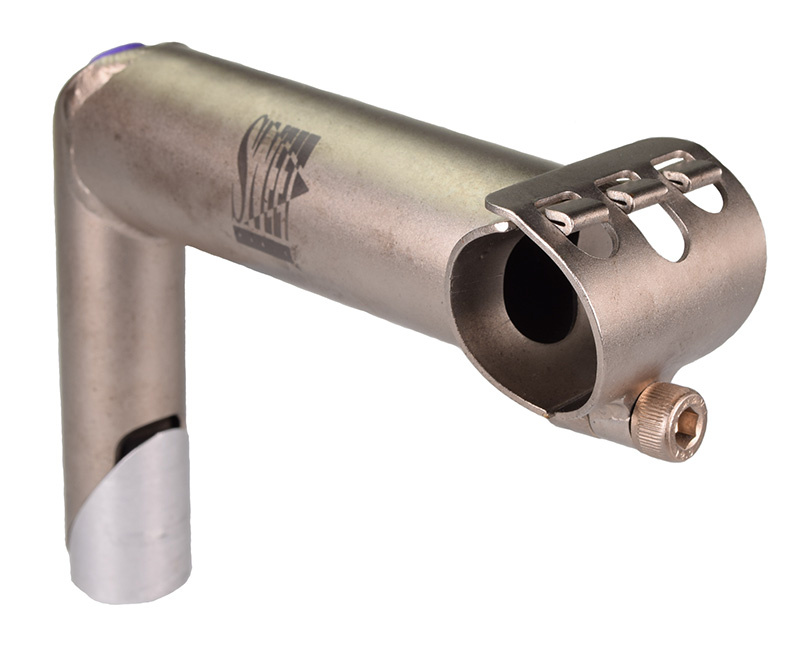
The ee years:
Then after a silent decade, comes the rise of ee. Without a doubt the eeBrake was a game changer, I don't think anyone could argue there has been a better all-around rim brake set....
When did you jump back in?
I started the brake design in October 2005. Here is my first sketch.
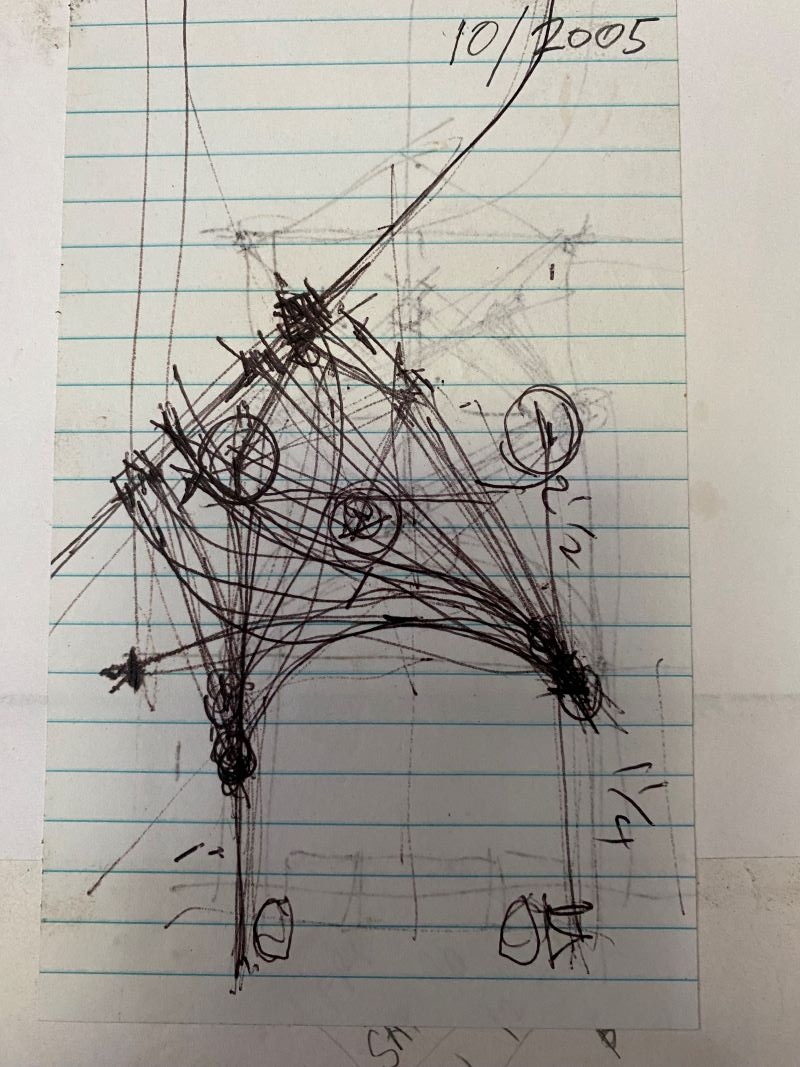
After such a long break from Sweet Parts, why come back to the industry?
I don't think I was finished with product design and I thought I had something good with the eeBrake. After the huge business failure of Sweet Parts, I wanted to see if I approached things differently, would it be successful? My new approach was: 1) No debt period. 2) Spend only the money on this project that I was willing to lose with a smile on my face. 3) No partners. I own everything and do everything myself. 4) No paid marketing. The product had to sell itself. 5) No deadlines. Do the work and take the time to do it right. 6) Build the best brake I could even if it meant redoing stuff. 7) Take nobody's money (payment) until I had something to ship them. 8) Treat people the way I would like to be treated. 9) Always be truthful with myself and others even if it was not fun. I started eeCycleworks with $25K - the amount I was all right with losing. I thought if you don't do this you will always regret not trying.
Was the eeBrake design something that just came to you in a moment of clarity or was this an idea that developed slowly over a longer period of time?
The eeBrake design came from the same place as the other designs in that I saw some things in the current brakes that did not make sense to me. The structural shapes did not make sense for the loads they were carrying. The basic design was 50+ years old except for the dual pivot feature. So I thought I might be able to do better. Structural efficiency/light weight and equal pad retraction were front of mind. This involved a totally new linkage configuration.
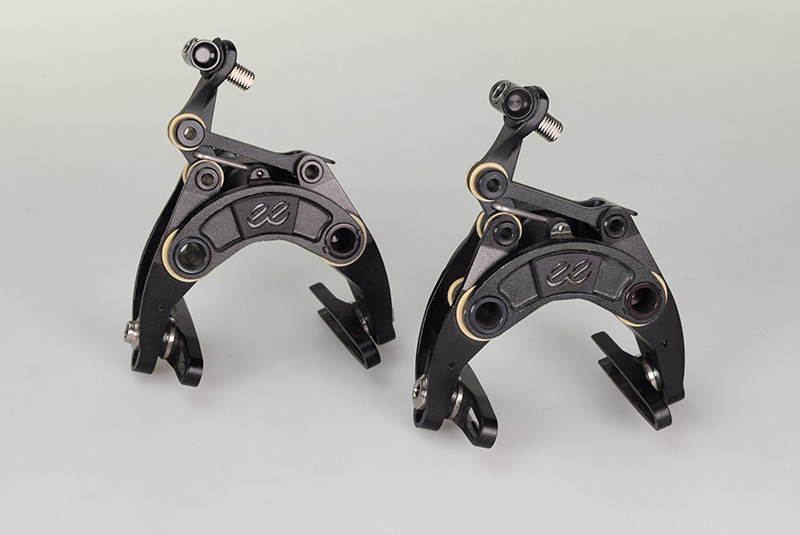
Your brake very clearly set a new benchmark for rim brakes. It undoubtedly influenced the design of several other brakes on the market. Do you see this as a compliment to the creativity and performance of your design or as a more negative view?
Yes, that is the polite way to look at it. One of my worst memories with eeCycleworks was the day I got an email from James Huang congratulating me on the apparent licensing deal I had gotten with one of the biggest American bike makers - He saw their new brake on their new models. Not having any such deal, when I saw the pictures he attached of the new brake, I was sick. It was a copy and they knew it and also knew there was probably nothing I could do about it. I was sick for a while and eventually just moved on.
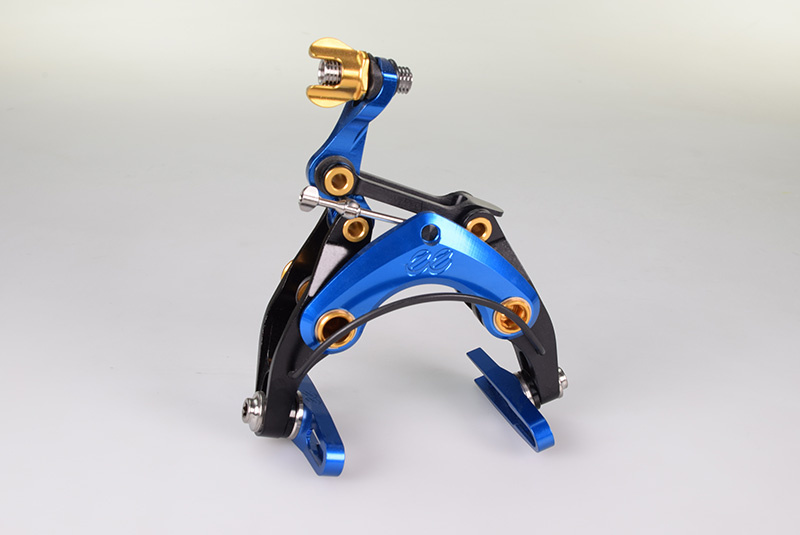
The current eeBrake in all it's glory.
You've got a hugely successful brake, then you decide to take another stab at cranks. The alloy eeCrank went through the multiple prototype/pre-production steps, but did it actually make it to the public release stage?
No, it was a huge failure and not for lack of trying. Feeling unsatisfied with the end of Sweet Parts, I could not stay away from trying cranks again. My concept was in part a response to some of the problems we had with the Sweet Wings. I was still going with big hollow sections for structural efficiency/lightweight/stiffness, but this time it was machined aluminum - NO PLATING, NO WELDING (I swore I would not do that again). Long story short, I worked so hard, built tons of prototypes, and spent a good amount of money trying to better what was out there. At the end of the day, it was not better enough when compared to the others to go forward into production even though I have specially extruded 2014 T4 material for the project. The competition had improved during this time too.
The Cane Creek years:

The eeBarKeep
At this point ee seems to be running well, why the decision to join the Cane Creek team?
Two things came together on this: 1) eeBrake sales were growing every year and I sold everything I could make. Keeping with the "do everything myself" principle, my wife and I were still assembling every brake ourselves. We would be sitting in front of the TV at night putting brakes together many nights a week. I called it "peanut work" because it was like shelling and eating peanuts at a baseball game. We had boxes and boxes of brake parts all over the house. This was a burnout and was limiting sales and eeCycleworks. 2) Brent Graves and I had worked on the 2 Specialized McLaren projects together outfitting eeBrakes on these bikes. Brent left Specialized to become the president of Cane Creek. Brent felt that adding the ee products to the Cane Creek line would be good for them and I liked the idea of getting out of the "peanut work" business. Besides the ee brand and ee products, our intention was to work together on product development with the idea that it would create a synergy where the sum would be greater than the parts.
 Another innovative design, the eeNut Expander.
Another innovative design, the eeNut Expander.Cranks, brakes, bar ends, expanders, is there anything else there that you did with Cane Creek that should be mentioned?
The eeSilk post and the eeSilk stem were also ee projects.

eeSilk seatpost, and stem
The eeWing cranks are quite nice. Are you 100% satisfied with them? I don't mean to suggest they are lacking. I mean to say that I know you've said over the years that you could go further with cranks and that you felt that way since the original sweet wings. I think the question is: Did the eeWings scratch that itch or do you think there is maybe even further you could go with them?
Short answer: No, I am never fully satisfied with anything I have done. It is amazing that after swearing to never do another weld part, I ended up ditching the CNC stuff and going back to the welded tubular concept of the 90s. This time it was TI instead of steel which got me out of plating!!! The structural efficiency of this concept is very hard to beat. I was re-convinced this approach could still (after 30+ years) outperform most. There are things about the current eeWings that were less than I wanted. I definitely think that there is a lot of room for the Wings to get better. Look at the best cranks out there - most of the good ones have had years and many models to refine and improve. So far with the eeWings, we have had 1 shot at it and that is with limited resources and opportunity to iterate. After seeing how well the eeWings (basic MTB crank arms) did against the best road cranks in the testing, I would love to see how real road specific eeWings could fare.

Early eeWing prototypes. You'll notice that these feature a 160BCD.
Looking at the EEwing alloy crank, one can't help but notice the 160 bcd spider, which is incredibly similar to the Praxis cranks of today. Is there a connection?
Praxis has always been great to me and David Earle is a long time friend. Yes, when developing that crank, David Earle and I did talk cranks together at length. Praxis (Dragon Tech) was making forged eebrake parts for me at the time too. David was very nice to hook me up with them for which I am thankful. Praxis was nice enough to make the prototype chainrings for my cranks which was obviously not a money maker for them. So the 2 bolt circle design I was using probably was a big influence for them. Campy went that way shortly after that time too. Even the current Shimano GRX crank uses a 2 bolt circle design as well. For me the 2 bolt circle design came in response to the very laterally stiff hollow chainring that Shimano developed at that time. The 2 bolt circle idea proposed to better stabilize/stiffen the large chainring for better shifting. 2 bolt circles - one for the big ring and one for the small one, allowed the spider to connect to the big chainring close to the teeth, giving it more lateral stability. I felt fine about others using the idea. I stopped pursuing that crank design and I never tried to patent it.
Borrowing ideas also happened with the Truvativ GXP BB system. It used the patented 2 bearing diameter feature of the Sweet Wings. Sweet went belly up so I did not mind.
The reality is, when ideas are exposed to the mind of creative designer types, there is a risk of them being of influence. That includes mine. Ideas are a dime a dozen. Really good ideas are rare. Actually developing a great bike part out of a really good idea is probably the harder part.
Do you want to talk at all about why/how your time with Cane Creek ended?
I continue to have a great ongoing relationship with Cane Creek. They continue to do a stellar job with ee from manufacturing to selling. We stopped working together in product development for now. The bottom line was we did not experience the synergy in product development that either of us was looking for. We do talk regularly, so I never say never. Maybe something like the next gen. eeWings could be a good opportunity.......

Craig's crank designs, from earliest to most recent (left to right) as well as an Sweet Stem and early eeBrake.
Today:
What are you up to today?
Currently, I am involved in a new US saddle company called Wove - Wovebike.com. We currently have a TT/Tri and a road saddle. Super light, but no compromise on comfort, made of carbon fiber.
I did a Gravel eeBrake project with Rob English of English Cycles. The typical "Arch style" Rim brakes have real problems accommodating the larger tires of gravel bikes. Because of the unique configuration of the direct mount eeBrake, it could be modified to handle gravel tires without sacrificing performance or adding much weight. It did however require wider mounting studs than that of the Direct Mount standard. I made the brakes and Rob made the custom frames and forks to fit. They are super cool and attractive to those who don't want hydraulic brakes for whatever reason.
I also developed a lightweight road carry tool with an integrated tubeless repair kit. It's called Craig's Tool and can be seen at Fit4Use.com and bought at Fair Wheel Bikes.
A multi-tool is a big change from super complex designs like cranks and brakes, and you've never wanted to release anything that didn't bring something new and improved to the table. What made you want to do a multi-tool?
I have been riding road for a long time and never could find what I wanted, so I decided to make what I wanted thinking other roadies would agree. It's in the standard Allen key L-shape, which is the most functional, has 6, 5, 4, 3, 2.5mm hex bits, Torx 25 bit, and tubeless tire repair bit with 15 repair plugs. All in just 38 grams. The tire plug in particular though is 6/4 Titanium and is sized and shaped for thinner plugs making it ideal for road tires. (most universal tools often target mountain tires.) It has the flexibility to be used for mountain or for really large holes in road tires because it allows for 2 plugs to be inserted simultaneously if needed.
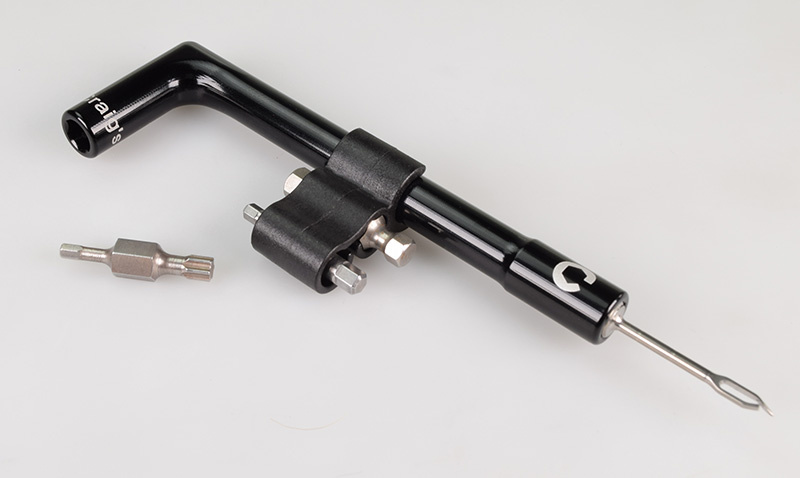
Craig's most recent project, 'Craig's Tool'.
What's next?
Honestly, only God knows.
You have the proverbial time machine, is there anything you're going to change?
I am content with no regrets. I do from time to time wonder where Sweet Parts would be if I would have been 100% focused on the company and bike parts then and did not have my energies/focus on architecture. I think we may be still around and making Sweet Parts!
You've always been on the cutting edge of design. Looking down the road do you see any new non-industry things (materials, techniques etc...) that you think may move the industry in new ways?
I think, like with everything else, the big guys are getting bigger and the small guys are having a tough time staying alive. As a result, fewer people are innovating in a way that affects the direction of the bike industry and a few big guys are deciding the direction of things and what is available for us to ride today. The number of places where the little guy can innovate and fit in is shrinking every day.
New? Maybe additive technology, especially in metal, offers some new possibilities and is somewhat accessible to a lot of people. That said, it does not solve every problem nor does it always compete cost-wise or perform favorably when compared to the conventional methods we have been using forever.
You set new benchmarks in the brake arena and even pushed forward the idea of function over form, that's a lot to contribute to an industry that isn't even your career. What are you most proud of during your time in the industry? (It doesn't have to be a particular product, it can be anything.)
I am very blessed, design has always been easy and natural for me. Somehow, I see things that others have a hard time seeing or don't see. For that I am thankful to God and really cannot take credit for it. eeCycleworks was a big experiment in a lot of ways. Seeing if a 1 man show could be successful with no formal training in engineering or business, by taking a little money and following some simple principles (listed above). This includes successfully manufacturing in the USA and Asia without ever going over there. It was enjoyable most of the time, ALWAYS A TON OF WORK and sometimes really tough.
I have always felt the best designs come from a single point of view/single mind and an absolute, unwavering, relentless effort. At the end of the day it is very fulfilling to see the market validate my ideas/bike parts with almost no marketing/media effort, competing with large companies with lots of engineers, huge product development budgets and large marketing departments. Also to see a business do well, keeping things as simple as possible, sticking to core principles about how to do things and the way people should be treated. It is encouraging to see that this way works in our dog eat dog world.
This has been a lot of fun getting to catch up with you had made me think a lot about the last 30 years in the industry. So a fitting question to end on would seem, what's your best memory of your time in the industry in the last 30 years?
I will never forget, back in the Sweet Parts days (1990s) the first time we got a booth at Interbike and showed the Sweet Wings. We had a huge crowd at our booth all the time. The Shimano engineering team came by with big smiles on their faces. After the show Kent, my partner and I drove back to LA late on a hot night, windows down, flying high with thoughts of our show success. We just smiled and laughed the whole way home thinking we just invented the internet or something...…
